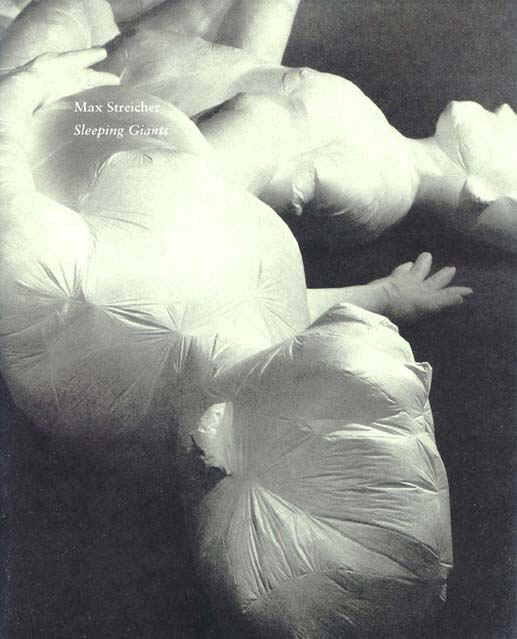Max Streicher
this flesh . . .
All things are transmutable, we learn as children: anything can become
something else and every place can be somewhere else. Objects can be
animate: independent lives can be created in toys, images, and
abstractions. Mysterious presences, experiences of extraordinary scale,
transforming characters and demons -- these are the very content and
fibre of the dream and nightmare world, spectres that pursue us
throughout our lives. The imaginary life of the child, and the fears and
fantasies of the adult, are connected by a common capacity for physical
joy and the awareness of physical frailty.
In his development of the inflatable as kinetic and interactive
artwork, and in his other multimedia installations, Max Streicher has
created images of our greatest joys and our deepest terrors, the site
where the imaginary lives of children and adults meet. Drawing on
imagery from literature, mythology, and the Bible (Streicher studied
theology before going to art school) his work provokes strong
spontaneous, psychological reactions in people of all ages and
backgrounds -- reactions that run deep and reveal insights into the
socially constructed ego.
A dream was the source for an important early work by Streicher
entitled We Will Name This Place..., 1988 (fig. 1). In the
Winter's College gallery at York University in Toronto Streicher removed
a large section of ceiling tile to reveal the building's inner
structure. Through this opening he installed three pâpier-maché
gargoyles -- dogs that appear to be charging from the sky. The
figures are a hybrid of Streicher's childhood dog, George, and gargoyles
seen by the artist on the cathedral in Swäbisch Gmünd, Germany.
Gargoyles, in the Middle Ages, were put on the outside of buildings to
ward off ghosts and malicious spirits. Dogs may be associated with the
hunt or the fear of being hunted. The same icon can be a benevolent
sign, however -- a messenger, a pet, or a companion on a spiritual
journey. Streicher used the gallery's acoustic ceiling panels as a
metaphorical skin, standing for the separation between interior and
exterior, conscious and subconscious realities.
The title We Will Name This Place... is a quotation from the
Bible referring to the dedication of sites where miracles had taken
place. At such a site a rock would be anointed with oil and the place
would be named. For the most part, miracles today are confined to
the pages of supermarket tabloids. But what of the world of dreams and
spirits, of clairvoyance and prescience? None of us can detach
completely from a world that is dark and irrational -- those aspects of
our experience that don't quite square with our mechanical, physical
understanding of the cosmos. Cracks occasionally occur in this
structure, puncturing our logical explanations and our propensity for
ordering -- "our cosmology." Through these cracks we
catch glimpses and we experience moments of insight, clarity, physical
ecstasy, and existential terror, coming to us in drips and drops and
splashes and waves -- like dogs pouring forth from above.
Perhaps this interest on the part of the artist in the leaky parts of
reality is less an attempt to describe the faults in our cosmology than
it is an attempt to describe the sacred in contemporary life. What is
sacred to us, what motivates our lives may not be sublime images of
heaven and earth, God and humanity, but rather the simple prospect of
financial gain, a new purchase, or a promotion at work. In The Life
We Are Living, 1990 (figs. 2 & 3) Streicher created a work that
was based upon his observation of the demolition of a church and the
construction, in its place, of a luxury condominium. The church tower, a
historical landmark, was preserved and the condominium structure built
to incorporate it. He imagined the construction worker as a spiritual
worker, a latter-day Levite constructing a temple to "speculative
real estate," embodying the spiritual values of Toronto in the late
eighties and early nineties.1
It may be a holdover of nineteenth-century romanticism in
contemporary culture that artists are directed to identify with the
mental patient, the prophet, or priest -- calling for spiritual values
in a materialistic and instrumentalized world. Condemning pleasures of
all kinds as vices, the spiritual outsider (read here the artist)
distrusts the world of sensation, preferring instead texts and the
interpretation of signs. Coming out of a Master of Fine Arts programme,
Streicher had absorbed these values, in effect not much different from
the values of the seminary school he had earlier attended. Streicher's
installation Panic and Fear, 1990 (fig. 4) is an ironic skewering
of such contemporary spiritual values. The installation, in a vacant
retail space in the Eaton Centre, Edmonton, consisted of a slide
projection of a mental patient carrying a sign that read, "I
know," and on the opposite wall a text: "Seeing now the
possibility of stilling forever our predisposition to panic and
fear."2 It is a bitter reflection and an outsider's
observation on the habit of pacifying existential anxiety through
shopping.
The first inflatable by Streicher was the work Breathe, 1989
(fig. 5) installed at the Bloor Street United Church. It was his first
work after graduate school, a piece he describes as whimsical, and at
the time not intended as a new direction or a sign of things to come. It
consisted of a sewn nylon bag, inflated by a vacuum cleaner. When fully
inflated, Breathe took the shape of a giant ram's horn. Each time
it inflated its motor and fan made a remarkably loud and high-pitched
sound and contrasted dramatically with the otherwise serene church
interior. There is something slightly rude about the piece: its size and
noise and its suggestion of a male erection.
Breathe made an impression on many people, including John Dickson and
Lyla Rye, who around that time found their own work tending to the
surrealistic and were looking around for like-minded artists to form an
artists' collective. They invited Streicher to exhibit with them and
other artists who later came to be known collectively as Nether Mind.3
Nether Mind's first exhibition took place in an old industrial basement
in the King Street West area of Toronto. Perhaps it was a combination of
factors: a collapsing economy (Streicher had just been laid off from his
day job at Bell Canada) and a dank, dark industrial basement as a venue
for this first show that generated the spirit that only a scarcity of
means and complete independence from institutional structures can
afford.
Streicher again returned to the inflatable for this group exhibition
and produced Boiler, 1991 (fig. 6). The figures in Boiler
were originally conceived as tripedal bunny suits-- each with three
ears, arms and legs tapered to points, like abstracted jesters. Viewers
animated the pieces by engaging switches that inflated them. The
inflation was startling, much like Breathe. The gloomy setting
only enhanced their ghostly presence. In the same exhibition, Streicher
exhibited Cellar. A blue sliding door in the same room as Boiler
opened to an even darker, danker space with water on the floor. Through
this door one could see limp, uninflated and very sad looking
"bunny suits" (the rejects of the Boiler research)
simply hung as though on meat hooks.4
The white, airy lightness and billowy softness of the Tyvek, the
synthetic, non-porous fabric that Streicher uses to make his inflatables,
inevitably recall clouds. In Where There Is Smoke, 1992 (fig. 7),
Streicher executed a private commission in the manner of a baroque
ceiling painter. The piece suggests the illusion of an opening through
the roof to the sky. It is a caricature of a cloud or of smoke, a
pulsating vision animated by the variable air currents of a rotating
valve mechanism.
Another play on this theme is Pillars of Cloud, 1992 (fig. 9).
The Pillars of Cloud were mounted on modified golf carts and
inflated by the squeezing of a hand break mechanism. The title is a
Biblical reference to when God was leading the Israelites out of Egypt
and he led them "by a pillar of cloud by day and a pillar of fire
by night." In the process of realization, the soft billowy
cloud forms gradually came to resemble more the sharp "peaks of
church steeples and Thai architecture."5 These pillars of
cloud are like modern conveniences or consumer appliances -- personal
augers to the promised land -- and seem as though they should be
available at any department or hardware store.
In The Life We Are Living, Panic and Fear, and Pillars
of Cloud, Streicher suggests that the character of our individual
lives is in fact the acting out of our deepest spiritual beliefs in the
vernacular of mass consumption and entertainment. As such, the promise
of salvation and the spectre of perdition guide us in every consumer
selection and choice of diversion. This theme is also unmistakable in
the work this flesh..., 1993 (fig. 10), exhibited in a solo
exhibition at Galerie Articule in Montreal. this flesh... featured a
16-mm film loop of an appropriated inflatable -- an effigy crudely
painted to resemble the Toronto discount retailer Honest Ed with two
sewn-on arms spread wide to welcome (or bless?) shoppers. The image was
projected on an arrangement of four mirrors that fragmented the image as
well as enhancing the cruciform character of the inflatable. An LED
scrolled a text from Tertullian, from the treatise On the Flesh of
Christ: "(I mean) ... this flesh ... suffused with blood ...
built up with bones ... interwoven with nerves ... entwined with veins
... as born of a human ... and knows how to die ... undoubtedly human
... (I mean) ... this flesh ..."6
The cruciform resemblance of the Honest Ed effigy may be merely
coincidental, but the Christ-like death and resurrection character of
many of Streicher's figurative inflatables is hard to miss. These
figures, even at their most abstract, remind us of physical life as both
miraculous and ephemeral. In the same exhibition at Galerie Articule,
Streicher installed in the office the ceiling-mounted inflatable My
Dear One (fig. 11). Recalling the earlier ceiling-mounted Where
There Is Smoke, My Dear One featured two large inflatable
arms, angelically hovering and embracing the office workers. Its
message, that of a Walmart greeter or of Honest Ed himself -- one of
throbbing, all-embracing love.
In contrast to the cotton-candy sentiment of the inflatable, the
Galerie Articule exhibition also included a third piece demonstrating
Streicher's acidic side. Alchemist's Tongue: of which my rage is made
/ of which my fear is made, 1993 (fig. 12), was an installation of
approximately fifty tongues, some cast in sulphur and some in lye soap.
The tongues had been cast in flexible moulds and bound differently for
each casting so that every tongue was unique.7
As a piece of human anatomy, the tongue is perhaps second only to the
representation of the genitalia in its suggestiveness. It may be for its
unique sensitivity that modesty insists that the tongue remain private
and contained and shared only in the most intimate relationships.
Streicher views the tongue as a threshold organ between inner and outer,
a basic surface for the investigation of the world,and here, a literal
description of emotion in both form and substance.
The example of Joseph Beuys's sculpture and installations from the
1960s through the 1980s, as well as the work of other artists,
encouraged many to explore an alchemical relationship to their
materials. Contemporary sculptors may now use a broader range of
materials -- materials that in themselves may stand for feelings,
emotions, or abstractions. For Streicher, Alchemist's Tongue in
lye and sulphur, and later kaolin, is about inner transformation, like
the dogs in We Shall Name This Place breaking through the
ceiling. Illuminated by flashing lights, there is a Faustian character
to these glow-in-the dark tongues -- eloquent and impossible to resist,
yet bitter to the taste.
Three installations / interventions followed in 1994 that had fun
with the conventions of language, interpretation and political
postures.8 Streicher returned to the inflatable in 1995 with the
site-related piece Stalk (fig. 13) in a temporary exhibition
space in the Scotia Plaza concourse in Toronto's financial district.
Directly across from the exhibition was the men's clothier Moores, whose
promotions for various lines of clothing featured models in wilderness
and hunting scenes. The artist, interested in the culture of business
and how it is expressed by the language of the hunt, decided in turn to
produce his own homage. He fashioned four rifle-toting hunters in peaked
caps following their five bloodhounds. A rotating valve inflated and
deflated the figures by turns to mimic a slapstick chase. While the
human figure had often been implied in Streicher's inflatables, Stalk
gave the artist the opportunity to work out his first full
figurative work.
Stalk again situates the artist in the outsider position. The
physical and ideological lives of the financial district are seen from
the outside. The cartoon-like figures of Stalk can only be read as the
artist's comment on the absurdity of the maniacal hunt for gold. The
piece also allowed Streicher to find a figurative role for the
inflatable. The carnival figure, the caricature, the Macy's Thanksgiving
Day parade inflatables now became points of reference.
"Where my work does make reference to popular culture it is,
I feel, to such things as freak shows, carnival and the tradition of the
grotesque; expressions of 'low culture' that assert the body as
undetermined, disrupted, leaky and in direct confrontation to the
contained and controlled body represented by the dominant culture."9
If not of the exuberant body, Quartet in a Box, 1995 (fig. 17)
seems to communicate a body out of control, eliciting strong feelings of
fear and loathing. Four inflatable figures arranged in a circle, each
connected to an air source through the top of the head, pulse and writhe
in response to changing air pressure. It may be their horizontality or
the way they seem to jerk and quiver as they inflate, as if in some kind
of seizure, that inspires such feelings of revulsion and morbidity.
Sextet, 1996 (fig. 18) was an enlargement on the Quartet in
a Box model, but by subtle changes in articulation and the location
of the air source Streicher could achieve an entirely different effect.
In Sextet the figures are inflated through the navel area and they come
to life in a way that is even more dramatic than Quartet in a Box.
The inflation is coordinated so that each figure is in a different state
of inflation or deflation at any one time. This movement takes place
quickly and creates the impression of a certain type of childish play
energy -- manic, reckless, dizzying, out of control.10
The occasion of the last Nether Mind exhibition in 1995 was the
stimulus for Balancing Act (fig. 18 & 19 opposite), one of
the artist's most elegant and eloquent pieces. Balancing Act
consists of two pair of figures suspended from the ceiling and inflated
by fans through rubber tubes in the area of the mouth.11 As a
figure quickly inflates, its chest fills and its arms thrust forward,
its back arches and legs and feet stiffen to a point. As it
deflates, the stiffness slowly disappears and the legs dangle down and
cross over. Streicher likens the effect to a dance, "as if dancers
had an exercise of having to make it appear as if all of the air were
draining from them."12
Indeed, there is a grace to the awakening and expiring acrobats, yet
within that grace there is also a startling and disturbing truth. When,
in the ballet Giselle, the tragic heroine dies after her dance
with the spirit of the woods, she gracefully succumbs to the stage
floor, her death the dance's denouement. The dancer acts as if dead and
the audience plays along, the saddest part being that she has finished
dancing. However, when the acrobat in Balancing Act loses air, it
is the illusion of physical life itself that disappears -- vanishes in
front of our eyes -- and becomes nothing more than a limp cloth bag.
Moreover, we have become intimate with these figures. As they inflate
and we hear the air rush into the body, we form a strange bond -- the
kind of feeling we experience with the breath of the other on our skin.
Yet, as Streicher is aware, "the source of that breath, industrial
fans and rather crudely fashioned valve mechanisms, are reminiscent of
respirators or some equally intrusive medical gadget, and this breath is
not life, just its sobering mechanics."13
Perhaps more than any other piece, Balancing Act makes us
focus on the central role of air and the imitation of breathing in
Streicher's inflatables. We relate to varying patterns of breathing, and
the action of air filling a body can suggest many things and elicit many
emotions. We breathe differently when asleep and awake, when we are
nervous, when we are calm. By adjusting and controlling the rhythm, the
sound and the speed of inflation and deflation, the artist manipulates
those perceptions and tells a story. Air, in the work of Max Streicher,
is indeed one of the substances of feeling.
The dragon exhibited with Balancing Act in the last Nether Mind
exhibition may have been an afterthought, in part because the warehouse
space for the exhibition was so vast. Streicher calls it a gift to the
show, "a prop, because Nether Mind shows were always more like
events or three-ring circuses."14 However, he had been
exploring the idea of scaling up his inflatables probably as early as
1993 when he appropriated the image of the Honest Ed inflatable in this
flesh.... The version of Boiler exhibited in the Naked State
exhibition in 1994 was a scaled-up version of the original to twice
lifesize. It was also around that time that the idea began for the
gigantic Swan Song (fig. 20), which he designed for the
exhibition Once Upon A Time at the Southern Alberta Art Gallery in
Lethbridge in 1996.15
In Swan Song Streicher was seeking "threatening beauty."16
He chose the swan because as an animal it is commonly known as a symbol
of beauty and elegance, but at the same time feared for its strength and
its potential for violence. Yard upon yard of silky white Tyvek in
softly undulating and pulsating forms created a dreamlike state for the
viewer to wade through. As in a dream, scale is distorted and no contour
is solid -- everything collapses to the touch or seems beyond reach.
"My intention is to overwhelm the gallery space and impose on
the viewer a sense of scale like that which a toddler might experience.
I am attempting to recreate a situation like that of childhood
encounters with humongous snow banks or haystacks; structures that
invite a physical exuberance which in turn leads the imagination .
. . In this work I want to physically embrace the viewer within a
tension between pleasure and threat, enchantment and self-reflexive
awareness."17
Sleeping Giants, 1998 (fig. 21, 22 & 23), exhibited at the
Cambridge Galleries, brought together the phenomenology of the physical
body first ventured in Quartet in a Box with the scale of Swan
Song. The giants in their great mass heaved and sighed to the timed
intervals of the fans. Lying on their backs and sides, heads rose from
the floor, legs stiffened, chests inflated, only to relax again, as if
in some futile attempt to get out of bed or off the couch. The giants
recalled the body as gross anatomy -- of a soul trapped within spoilable
flesh -- the dispirited body, incapable of action because of the
sentiment of futility. The giants also recalled the tragic body -- the
self perpetuating machine -- needy, voracious, desiring,
independent of consciousness and will.
The inflatable as art -- the balloon, the soap bubble, the inflatable
toy -- until now, has been dedicated to children. Max Streicher has
taken the inflatable, the prepubescent symbol of wonder and tragedy and
rehabilitated it, or rather, he has given it an adult life. He has done
this not by stripping the inflatable of those characteristics that
appeal to children, but by probing those aspects that are fundamental to
understanding ourselves. We favour children with balloons and they in
turn are fascinated by their lightness, enthralled by their buoyancy,
and devastated when they break. With each balloon, we create a round,
pudgy, brightly coloured life -- symbolizing at once our joy in creation
and our awareness of life's fragility. And therein lies its magic: the
inflatable makes the abstract character of our organic existence
visible. We know we were born from nothing, we feel our breath now, and
we know that we will expire.
Gordon Hatt
|
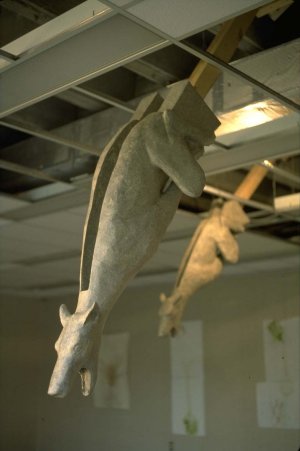
(fig. 1) We Will Name This
Place..., 1988, installation at Winter's College gallery, York
University. (Permanent installation at Fine Art Building, Phase II, York
University.) Photo: Max Streicher.
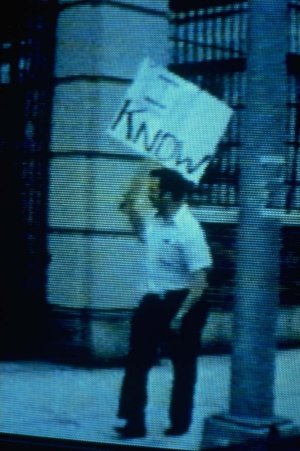
Fig. 3 Panic and Fear, 1990, slide
projection, text, installation, Eaton Centre, Edmonton, Alta., "The
Works" Festival.
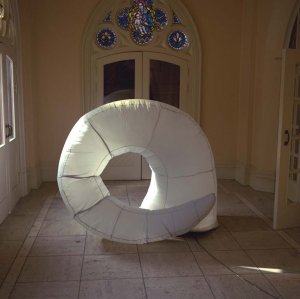
Fig. 5 Breathe, 1989, "The
Crossing," Bloor St. United Church. Coordinated by Mediums Art
Centre, Toronto.
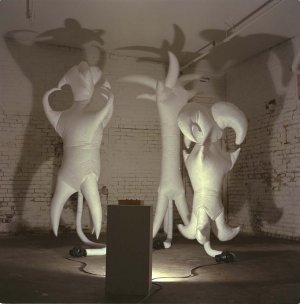
Fig. 6 Boiler, 1991, Tyvek, fans,
duct, and switches, 300 cm. high., Nether Mind collective exhibition,
1991.
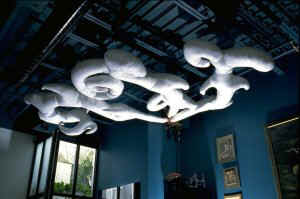
Fig. 8 Where There Is Smoke, 1992,
installation. Collection of Marat Inc., Toronto.
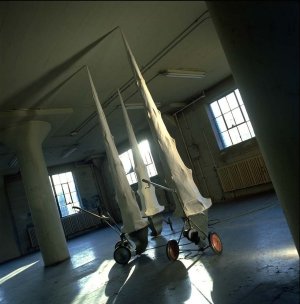
Fig. 9 Pillars of Cloud, 1992,
Tyvek, modified golf carts, fans and switches, 351 cm high, Nether Mind
Collective exhibition.
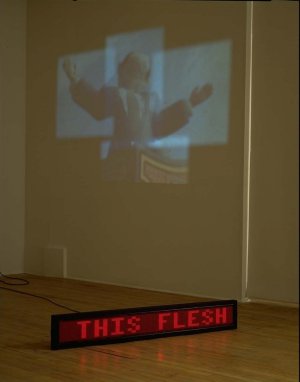
Fig. 10 this flesh . . . ,
1993, 16 mm film loop, mirrors and LED sign, projection size: 190 x 190
cm, Galerie Articule, Montreal.
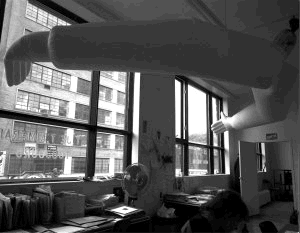
Fig. 11 My Dear One, Tyvek, fan,
flexible duct, lights, 10 m finger tip to finger tip, Galerie Articule,
1993.
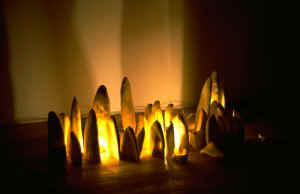
Fig. 12 Alchemist's Tongue: of which
my rage is made/of which my fear is made, 1993, cast sulfur and lye
soap, flashing light bulbs. tongues: 8 to 45 cm high, Galerie Articule,
Montreal, May, 1993.
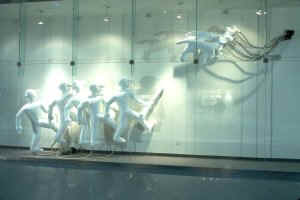
Fig. 13 Stalk, 1995, Site-specific
installation, Paul Petro Contemporary Art, Scotia Plaza, Toronto, 1995.
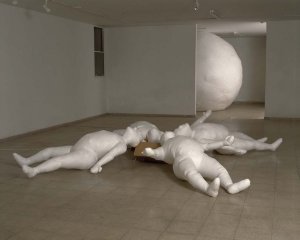
Fig. 17 Quartet in a Box, 1995,
Tyvek, electric blower, flexible duct cardboard box, 190 cm tall x 42 x
42 cm. , 00 Gallery, Halifax, Nova Scotia.
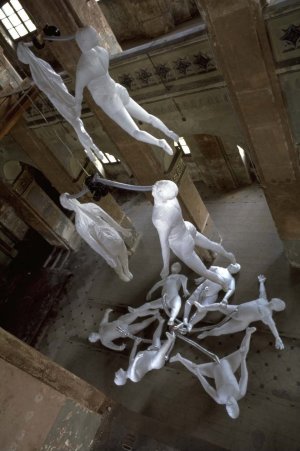
Fig. 18 Sextet, 1996, each figure
250 cm high and Balancing Act, 1996 version, each figure 190 cm high,
installation at Synagoga na Palmovca, Prague, Czech Republic.
Photo: Daniel Sperl.
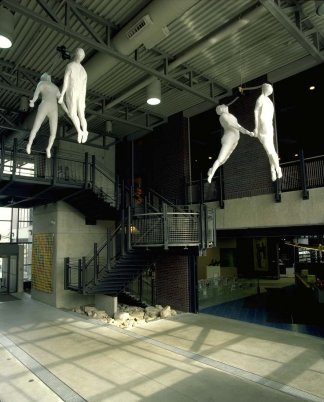
Fig. 19 Balancing Act, 1995,
Tyvek, electric blowers, flexible duct, 190 cm tall, Cambridge
Galleries, The Library & Gallery, Cambridge, 1998. Photo:
Robert McNair.
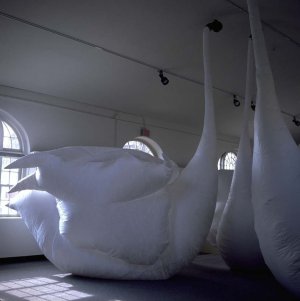
Fig. 20 Swan Song, 1996, Tyvek,
electric fans, switches 14' high, "Once Upon a Time," Southern
Alberta Art Gallery.
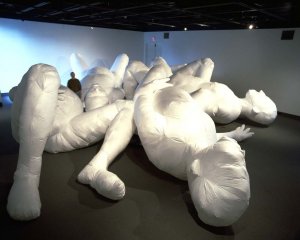
Fig. 21 Sleeping Giants,
1998, installation, at the Cambridge Galleries, the Library &
Gallery, Cambridge, Ontario, 1998.Photo:
Robert McNair.
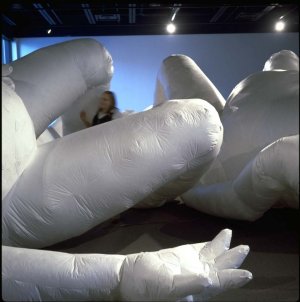
Fig. 22 Sleeping Giants, 1998,
installation, at the Cambridge Galleries, the Library & Gallery,
Cambridge, Ontario, 1998.

Fig. 23 Sleeping Giants, 1998,
installation, at the Cambridge Galleries, the Library & Gallery,
Cambridge, Ontario, 1998. Photo:
Robert McNair.
|
